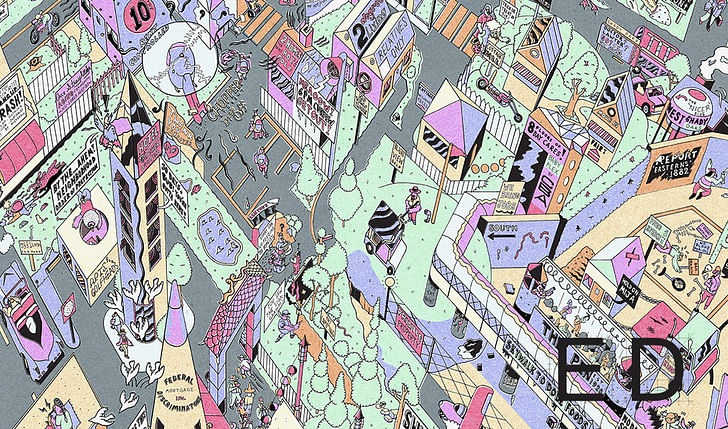

A project several years in the making, Interboro Partner’s new book The Arsenal of Inclusion & Exclusion is a field-guide to the often-imperceptible codes and conventions that are as responsible, if not more, for the form of the contemporary city than traditional design. Like modern-day urban detectives, the Brooklyn-based studio shows that seemingly innocuous things, from zoning to parking restrictions, are responsible for either making the city more accessible or more closed-off, often depending on who you are or what you look like.
In this excerpt from a special feature for Ed, Interboro Partners break down some of the tactics used to open and close the city.

Apartment Size
Developers and planners sometimes use apartment size as a proxy for tenant types. For example, a developer who thinks it will be easier to lease and maintain apartments for singles can build studio and one-bedroom units and safely assume that families with children will look elsewhere.
Controversies surrounding apartment sizes are familiar in New York City. When, in the summer of 2011, Mayor Michael Bloomberg announced a city-sponsored competition to design and build “micro-units” that would be smaller than what is allowed under current regulations, housing advocates, community leaders, and elected officials protested, claiming that micro-units ignore the needs of large, poor families. Micro-units may “broaden housing choices for New Yorkers,” as Planning Commissioner Amanda Burden put it, but they are a very particular kind of New Yorkers: “the growing number of young and creative individuals looking to move to our city or remain here,” in the words of Rick Bell, Executive Director of the American Institute of Architects New York.
When it comes to affordable apartments, one size definitely doesn’t fit all
Indeed, the micro-unit illustrates the fact that including one group often means excluding another. Bloomberg aligned the competition with his multibillion-dollar “New Housing Marketplace Plan” to finance the creation or preservation of 165,000 units of affordable housing, but affordability isn’t always synonymous with accessibility. When it comes to affordable apartments, one size definitely doesn’t fit all: there might be an undersupply of affordable small units, but there is an undersupply of affordable large ones too: The New York Times reports that of the city’s 2.1 million rental apartments in 2011, 14 percent were three-bedroom units and only 2 percent were four-bedroom units or larger.
To further complicate the issue, if building apartments that are too small can earn you the enmity of families, so too could building apartments that are too big. In a 2012 case that went before the Manhattan State Supreme Court, a judge halted a city-sponsored affordable housing development planned in Brooklyn, asserting that it illegally excludes prospective black and Latino occupants. Why? In one version of the plan, more than 40 percent of the apartments would have three or four bedrooms, which, the plaintiffs successfully argued, would have favored the area’s Hasidic Jewish community.
Sources
“1970s–Present: Restriction of Multi-Family Housing.” The Fair Housing Center of Greater Boston. Accessed July 2014. http://www.bostonfairhousing.org/timeline/1970s-present-Local-Land_use-Regulations-2.html.
Hu, Winnie. “Some See Little Room for Large, Poor Families in Mayor’s Housing Plan.” New York Times. October 19, 2012, accessed July 2014. http://www.nytimes.com/2012/10/20/nyregion/large-poor-families-are-left-out-of-new-yorks-housing-plans-officials-say.html?pagewanted=all.
Kelly, Meg. “Why Is the Broadway Triangle Still Empty?” Urban Omnibus. August 15, 2012. http://urbanomnibus.net/2012/08/why-is-the-broadway-triangle-still-empty/.

Armrest
For many nascent urbanists, this is where it all begins, with an excerpt from Mike Davis’s City of Quartz and an ensuing epiphany about space and power. While a somewhat hackneyed example, the armrest on the park bench remains a straightforward illustration of how access to space can be controlled without much ado. The armrest is all the more insidious for how subtle it tries to be, masking its exclusionary intent as a utilitarian or decorative element of the bench’s design.
Granted, for some older adults and people with physical disabilities, armrests make benches more accessible by providing firm support for sitting and rising. Additionally, by creating a small buffer between bench sitters, armrests can produce a sense of privacy that, according to the Project for Public Spaces, may actually encourage people to sit closer together. Yet decorative armrests, specifically when installed at the midpoint of benches, can also fulfill a more sinister purpose: deterring the homeless from sleeping in public spaces. Ubiquitous in urban parks and at bus stops, such armrests make benches impossible (or at the very least unpleasant) to lie down on.
Buzzer
Buzzer security systems are a common sight in many U.S. cities, regulating the flow of people through apartment complexes, office towers, gated communities, and even some bars and stores. Often equipped with cameras or microphones, the systems enable residents, guards, or workers to screen potential visitors. While buzzers are thought to make spaces safer, their installment can also lead to illegal forms of profiling.
While buzzers are thought to make spaces safer, their installment can also lead to illegal forms of profiling.
In 1986, Washington Post columnist Richard Cohen set off a wave of controversy by defending a well-known practice among Washington, D.C., shopkeepers: denying entrance to young black men. At jewelry stores in particular, the installation of buzzer security systems enabled employees to informally screen potential customers and—if they fit a certain (racial) profile—refuse to unlock the door. Cohen, who is white, reasoned that because a majority of the city’s robberies were committed by young men of color, such discrimination was not actually informed by racism: it was just common sense. “The mere recognition of race as a factor… is not racism itself,” he wrote. “Both blacks and whites believe those young black males are the most likely to bop them over the head.” Of course, the actions of these storeowners were, and still are, in direct violation of the Civil Rights Act; spaces of public accommodation cannot be restricted on the basis of race. Yet as a mediating technology, buzzer security systems allow for such “common sense” bigotry to be easily, impersonally acted on—thus producing a humiliating geography of exclusion.
Camping Ordinance
In May 2013, the city council of Pensacola, Florida, outlawed camping on public and residential property within city limits. Citing the “aesthetics, sanitation, public health, and safety of its citizens,” the council banned bathing or shaving in public restrooms and cooking outdoors over an open fire. Most controversially, the council’s definition of “camping” also included sleeping “adjacent to or inside a tent or sleeping bag or atop and/or covered by materials such as a bedroll, cardboard, newspapers or inside some form of temporary shelter.” Thus “blanket ban,” according to its critics, essentially criminalized homelessness under the guise of regulating recreational camping.1
After its passing, the ordinance generated a great deal of public outcry and unflattering press. In addition to protesting in the city council chambers, a former priest named Father Nathan Monk began a Change.org petition that gathered more than 20,000 signatures in favor of repealing the ban. Vice also ran an article declaring the ordinance “total bullshit” and Pensacola “the redneck Riviera.” Eventually the city’s mayor spoke out against the law, after having initially supported it, and even posted photos on Instagram of his wife heading to a blanket drive. By February of the next year, the council voted unanimously to repeal the blanket ban sections of the ordinance, though leaving other prohibitions on washing and cooking intact.
1. Since the 2008 home mortgage crisis, homelessness has been on the rise in Florida. However, according to the state’s Council on Homelessness 2013 Report, Escambia County (where Pensacola is located) saw its homeless population actually decrease from 1,247 in 2007 to 830 in 2013. That being said, the population had been at 549 in 2011, thus rising dramatically in the two years immediately preceding the camping ordinance. See: Felix, Melvin. “Florida economy blamed for rise in homeless population.” TCPalm. Jan 12, 2011, accessed August 2014. http://www.tcpalm.com/news/florida-economy-blamed-for-rise-in-homeless.

Fire Truck
In 2013, controversy erupted in Chappaqua, New York (pop. 9,400) surrounding a proposed four-story affordable housing development called Chappaqua Station. If completed, the building will consist of 28 rental units with caps on family earnings and will be situated in what is a small, weed-covered field between Metro-North Railroad tracks and a parkway exit ramp. Yet, as The New York Times reports: “The building inspector, William J. Maskiell, contends the site is hazardous because there is insufficient width around some sides of the building for fire ladders to gain access” and “an arched stone overpass leading to the site is too low to permit the largest fire trucks to pass.”
communities today turn to more subtle, often nonsensical claims to keep their communities economically and racially homogeneous
In response, the developer contended that few apartment buildings are accessible on all four sides. What’s more, there is photographic evidence that the town’s ladder fire truck has no problem clearing the overpass. A New York City assistant fire chief even added his two cents, stating that the development would be “the safest building in town.” Randolph M. McLaughlin, a civil rights lawyer who represents the developer, maintains that the delays have more to do with classism and racism than fire trucks. While explicitly discriminatory language is taboo, he explained to The New York Times, communities today turn to more subtle, often nonsensical claims to keep their communities economically and racially homogeneous.
For more, grab a copy of Ed #1 "The Architecture of Architecture" here.
Purchase a copy of The Arsenal of Inclusion & Exclusion here.
No Comments
Block this user
Are you sure you want to block this user and hide all related comments throughout the site?
Archinect
This is your first comment on Archinect. Your comment will be visible once approved.